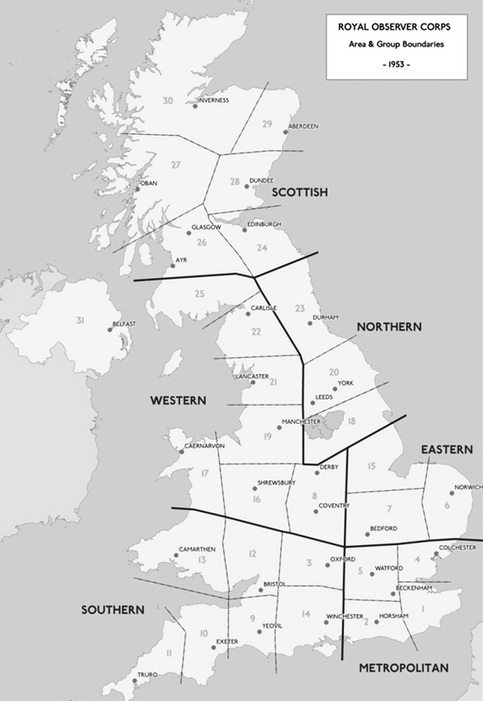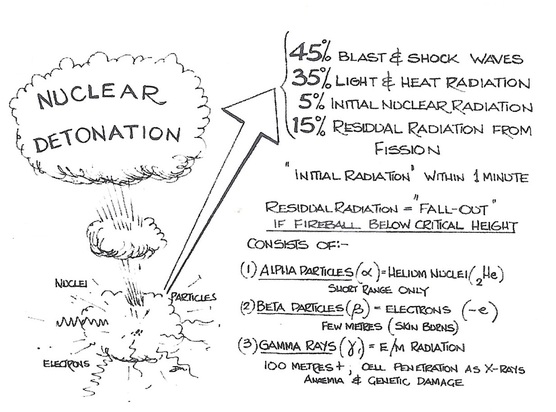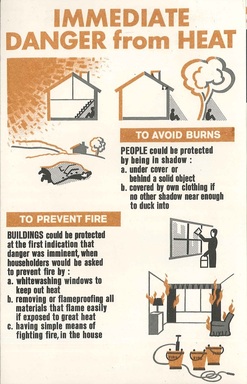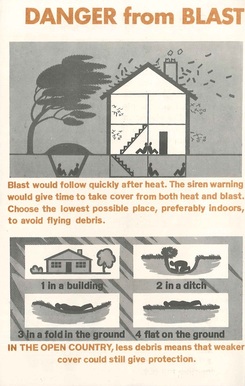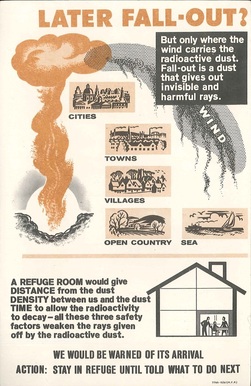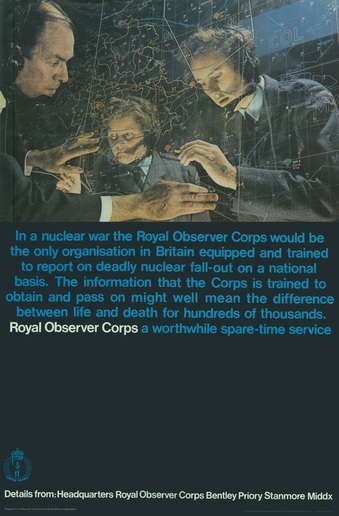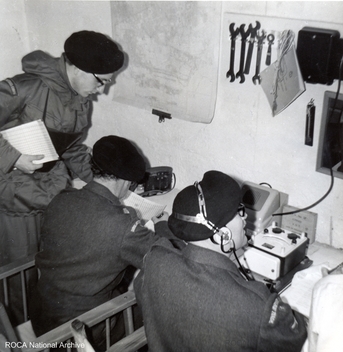1950's: FROM WW2 INTO THE COLD
|
From Aircraft Observation to Nuclear Monitoring
When the dust had settled in 1945 the incredible pace of development of fighting weaponry, had given, only too well, the clues to the future. On the allied side, the Atom bomb had given them a weapon which had ensured the surrender of Japan; the Germans had developed the V2 rocket which was mobile and able to be fired from any site, and for which the allies were almost powerless. The ROC continued to monitor the skies after the cessation of hostilities, and was keen to develop new ways to;
|
|
In September 1947, over a year after VE Day, the ROC held its first small scale exercise in southern England, which included for the first time substantial numbers of jet aircraft. Another year later the first large scale exercise took place; in the last two of its four days of this radar only was used.
By the end of the 1940’s the Commander-in-Chief of the RAF’s Fighter Command, Air Marshall Sir Basil Embry, realised the fragile nature of UK air defences with reaction times of defences being based on the wartime communication structure [1] and was deemed to be too slow to respond to the growing threat from the expansion of Soviet Forces and air power and especially in response to their related developments in nuclear weapons. Embry concluded that there wasn’t deemed to be a need for Group Operations Rooms with operations being controlled more effectively through Sector Commanders. These concerns by Embry eventually culminated in the development of the “Rotor Plan”. This plan involved;
- The transfer of RAF sector operations centres and GCI [2] radar staff into new purpose built underground bunkers which were deemed safe from conventional and most of the nuclear weapons at the time.
- The extension of the Control and Reporting organisation using the latest early warning equipment and therefore to provide cover up the east coast to Aberdeen; down the west coast and eastwards to Portland Bill.
- 16 Chain Home radar stations were to be overhauled to provide significant cover within the radar network.
| ROC Communication Network | |
| File Size: | 6322 kb |
| File Type: | |
Initial Corps’ Structure during the early Cold War period
The new Rotor Plan involved the change in RAF operational sector areas which provided the opportunity for the ROC to reconfigure its own sectors to match more closely those sectors of the RAF and providing more operational effectiveness for both organisations. The reorganisation of the ROC sector areas was scheduled for completion by 1st November 1953. The Groups were reorganised with the numbers being reduced from 40 to 31, and with the Corps now covering Northern Ireland for the first time.
|
The Nuclear Threat
The development and use of the atomic bomb in 1945 and subsequent development of Hydrogen bomb by the US, UK and Soviet Union outlined the need to reappraise the role of the ROC after WW2. The overall role of the the ROC in respect to aircraft monitoring was diminishing as the role became ever more harder as the speed of aircraft became greater. Furthermore the impact of nuclear weapons was far greater than conventional bombs used during WW2. In effect, conventional weapons apart from having a lower yield than nuclear generally were limited in respect to their overall effects. There was danger from the blast of the weapon but in most cases little more. Nuclear weapons in comparison were in effect different in that the yields of such weapons were generally much larger but also there was also the added impact of its; 1) Heat Effect, 2) Blast Effect and 3) Potential Fall-out |
|
|
Protect and Survive These Protect and Survive films were produced in the 1970's and would have been released to be shown to the public in the event of a nuclear attack on the United Kingdom. The films aim to explain to the population the effects of a nuclear attack on the UK i.e. Danger from Heat, Blast and Nuclear Fallout; what to do in the event of an attack and how the population can protect themselves. |
The ROC's Changing Role
The ever growing tensions between the West; dominated by the US and UK and the East; dominated by the Soviet Union culminating in the so called Iron Curtain and "Cold War" ultimately led to the greater risk of nuclear war. As a result, the need for effective warning and monitoring if the inevitable did occur, was needed.
The ever growing tensions between the West; dominated by the US and UK and the East; dominated by the Soviet Union culminating in the so called Iron Curtain and "Cold War" ultimately led to the greater risk of nuclear war. As a result, the need for effective warning and monitoring if the inevitable did occur, was needed.
Changes to the role of the ROC in the defence against nuclear weapons was therefore announced in the House of Commons on the 15th June 1955:-
“… Steps are being taken for the ROC to give warning of and to measure radioactivity in the event of air attacks in a future war.”
The ROC was given the task of reporting any nuclear bomb bursts and monitoring the resultant radioactive fall-out. The ROC was obviously suited to this new role; the Infrastructure and lines of communication were already in place and the personnel involved were familiar with the monitoring equipment. The first significant exercise involving the ROC in handling nuclear data was in 1956. The aircraft spotting and identification responsibilities of the ROC diminished during the 1950s and were replaced by the need for nuclear warning and monitoring.
| ROC New Role | |
| File Size: | 6216 kb |
| File Type: | |
UKWMO (United Kingdom Warning & Monitoring Organisation)
In 1957 the British government's policy of reliance on nuclear weapons became clear. Within ten years the aircraft recognition and reporting role of the ROC had all but gone. Later in 1957 the United Kingdom Warning and Monitoring Organisation (UKWMO) was set up under Home Office control and funding, with five main functions;
- Warning the public of any air attack – conventional or nuclear.
- Providing confirmation of nuclear strike.
- Warning the public of the approach of radioactive fallout.
- Provision of a post-attack meteorological service for fallout prediction.
- Supplying the civilian and military authorities in the United Kingdom and neighbouring countries in NATO with details of nuclear bursts and with a scientific assessment of the path and intensity of fallout.
|
Altogether more sophisticated than its earlier role; the ROC formed part of the United Kingdom Warning and Monitoring Organisation (UKWMO) which was the only organisation in Britain equipped and trained to report on radioactive fallout on a national basis. The fact that the Corps was trained to obtain and disseminate this information might have well meant the difference between life and death for many of us.
It was intended that the UKWMO would provide both civil and military authorities in the UK with essential information during a nuclear attack, with the ROC providing primary data on the position and magnitude of atomic weapons detonated during any such attack. This data would be used by the UKWMO, in conjunction with weather information provided by the Meteorological Office, to produce a forecast of radioactive fallout. Fallout would be monitored as and where it occurred, with its actual location and strength mapped using data obtained from instrumentation at ROC posts. Such information when combined with Meteological data based on actual wind speed and direction obtained from cluster master posts would permit the dissemination of accurate forecasts predicting the distribution and strength of nuclear fallout. Going Underground Bacause of this change in role from overground observeration to nuclear monitoring, the Corps' had to undergo a complete transformation. The overground monitoring posts and especially the reinforced Orlit posts constructed between 1951 to 1954 for use in observing enemy aircraft were deemed to offer little protection from the risk of nuclear attack and any resultant risk of fallout. It was therefore decided that protected underground posts would be investigated and which were developed to assist the Corps' to undertake their new monitoring and warning role. |
Recruitment film produced for the ROC in 1977
The first operational protected post was developed at Farnham, Surrey in 1956 after rigorous tests and experiments had been undertaken as part of nuclear tests in Australia. The post proved such a success that a programme of works was developed to build a network of posts across the United Kingdom following a similar network structure as per the overground posts. The programme of works was developed to be completed by 1963 with an estimated 100 posts completed in the first year followed by 250 posts to be built each year thereafter. In total by 1963, approximately 1500 underground posts had been constructed and which were designed to provide a satisfactory blast protection and be able to be used self-sufficiently for a number of weeks if an attack on the UK had occurred.
The videos below were produced by the United Kingdom Warning and Monitoring Organisation in 1962 and later in 1971. The films were aimed to highlight the role of the UKWMO and ROC in the event of a nuclear attack on the United Kingdom.
|
|
|
[1] This communication structure was from Group Control to Sector Control to RAF Station.
[2] Ground-Controlled Interception (GCI) is an air defence tactic whereby one or more radar stations are linked to a command-communications centre which guides
interceptor aircraft to an airborne target.
[2] Ground-Controlled Interception (GCI) is an air defence tactic whereby one or more radar stations are linked to a command-communications centre which guides
interceptor aircraft to an airborne target.
Image Source: ROCA National Archive
Map Source: South Yorkshire ROC Collection
